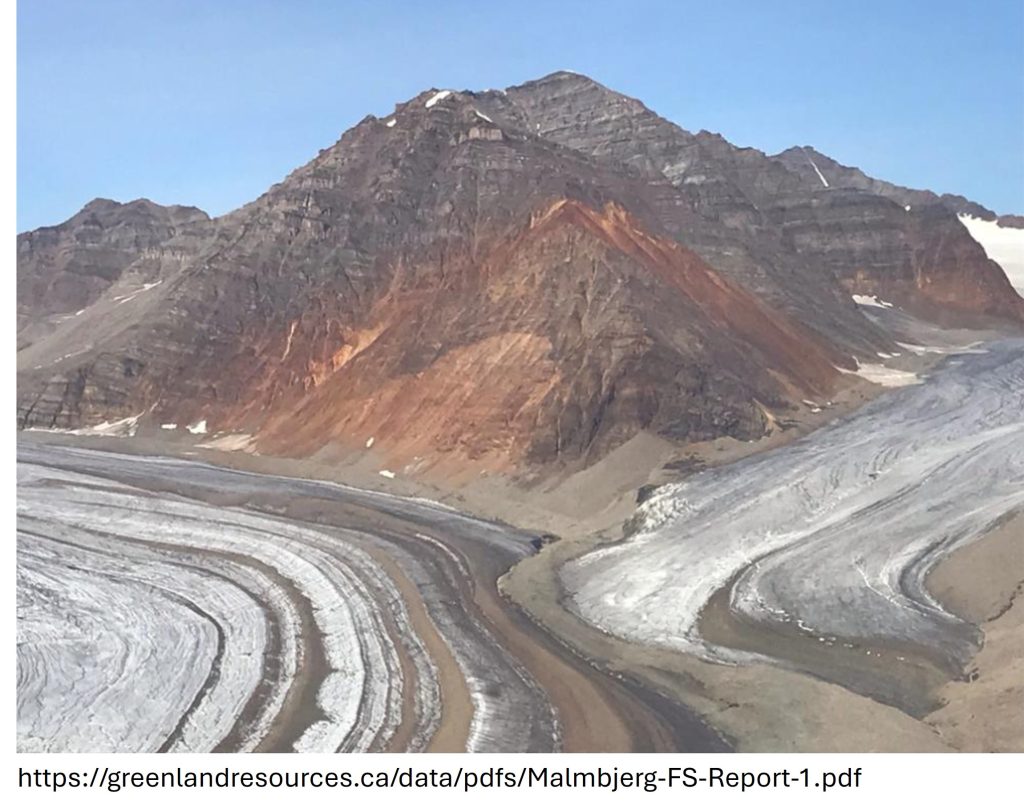Greenland: The Frozen Frontier of Critical Minerals Part 1: Emerging Opportunities

Greenland is one of the most remote, sparsely populated, and inhospitable places on Earth, but yet is has often wielded outsize importance. Over the centuries is has been an outpost for Viking exploration, a strategic cold war base, and a hotbed of geological research. Today the changing tides of geopolitics and threats to critical minerals supply chains have once again thrust the world’s largest island and its largely untapped mineral wealth into the spotlight.
This is the first part of a two-part article: it provides an overview of mining activity in Greenland with a focus on opportunity. The second part will examine the future of mining in Greenland and outline key challenges to be overcome.
Rich zinc sulfide ore (brown) mixed with white marble at the former Black Angel mine site.
Greenland at a Glance
Greenland is the world’s largest island at 2.17 million km2; this about 24% the size of the United States, although high-latitude distortions in the standard Mercadier projection map makes it appear much larger. About 81% of Greenland is covered by an ice sheet up to 3 km thick. Although most of Greenland lies within the arctic circle its coasts are warmed by ocean currents and remain largely ice free.
Fluctuations in Greenland’s climate have driven repeated waves of settlement and abandonment by Inuit and later Nordic peoples over thousands of years. Today Greenland is a self-governing territory of Denmark; foreign policy, defense, and funding is set in Copenhagen, while domestic policy, including resource management, is controlled by the Greenlandic government. The population is just under 57 000; the capital, Nuuk, has just under 20 000 residents.
Although most Greenlanders support full independence, Greenland is economically dependent of subsidies from Denmark, and few believe it will be able to stand alone without a more sustainable economy. Greenland’s trove of mineral wealth may be the key to its future or its undoing.
The American Factor
Since 2019 Donald Trump has repeatedly and publicly called for America to purchase, or even forcibly seize, Greenland from Denmark, claiming the US should have control of Greenland’s critical minerals and strategic position is needed for national security.
Trump is not first American president to threaten Greenland’s sovereignty. Several administrations have tried to acquire the island over the last 150 years. During World War Two American troops occupied the island to secure both its strategic position and its unique cryolite mine. Cryolite was a wartime necessity for the production of the aluminum used in fighters and bombers.
The Ivittuut pit, which has since filled with water, was once the source of a unique strategic resource.
The American military maintains a presence in Greenland in the form of Pituffik Space Base (formerly Thule Air Base), a vital strategic outpost for monitoring Soviet and Russian military activity. In 1968 Thule was the site of an infamous incident where a B-52 carrying four nuclear bombs crashed, spreading radioactivity over the area and leaving one bomb missing to this day.
Emerging Opportunities
Greenland has long seen mining as an opportunity to expand its economy, even going so far as to openly court Chinese investment at a time when many western governments have grown wary.
From a resource perspective it would be quicker to list what Greenland doesn’t have. Base metals, precious metals, rare earth elements (REEs), lithium, graphite, gemstones, uranium, and industrial minerals can all be found here. The retreat of Greenland’s glaciers reveals more bedrock, and more potential resources, every day. The emergence of new melt-fed rivers provides opportunities for hydroelectric power. Although oil and gas reserves are expected to be present, limited exploration efforts have been unsuccessful so far.
The key to this resource diversity is Greenland’s varied geology and its almost complete lack of vegetation. This bedrock exposure makes it an ideal place to study rocks, both from an economic and scientific perspective. The island hosts some of the world’s oldest rocks, which are about 3.8 billion years old, but also younger sedimentary rocks rich in dinosaur fossils, as well as more recent igneous rocks, such as the famous Skaergaard Intrusion, related to the opening of the Atlantic Ocean. Greenland is also known for alkaline intrusive complexes, rare igneous rocks highly enriched in volatile elements and rare metals.
Mining in Greenland Today
Despite the attention, there are currently only two active mines in Greenland: The Nalunaq gold mine and the White Mountain (Qaqortorsuaq) anorthosite mine.
Nalunaq, owned by Amaroq Minerals, is one of the highest-grade gold mines in the world, with inferred resources of 355 kt at 28g/t. Nalunaq produced 367 koz of gold between 2004 and 2013 under previous operators. The mine poured its first gold under Amaroq ownership in late 2024. Nalunaq is considered an orogenic gold deposit, with mineralization hosted in narrow, structurally controlled quartz veins. Amaroq also holds a portfolio of early-stage gold, copper-gold, and iron-titanium-vanadium projects across southern Greenland.
White Mountain is owned by Lumina Sustainable Materials, a privately owned company. Few details are publicly available, but production appears to be quite small, perhaps just a few hundred tonnes a year. The anorthosite, a coarse-grained igneous rock made up of >90% calcium-rich plagioclase (NaAlSi3O8-CaAl2Si2O8), from White Mountain is said to be particularly pure, making it useful for industrial applications such as fiberglass production. Anorthosite has also been proposed as an environmentally friendly source of aluminum, but this has yet to be demonstrated on a large scale.
Despite anorthosite being a rare rock, almost everyone on Earth sees it regularly. Anorthosite makes up the lunar highlands, the white, reflective part of the moon’s surface. As the moon’s primordial magma ocean cooled low density plagioclase floated to the top and froze into a gleaming white shell. Later eruptions of black basalt formed the famous ‘man in the moon’ pattern.
Historic Greenland Mines
While Greenland’s mineral potential has been recognized for centuries, attempts to mine here have met with mixed results. Struggles with access, infrastructure, and harsh climate have led to many failures.
The most significant mine in Greenland’s history was Ivittuut. From 1859 to 1987 Ivittuut was the world’s only source of cryolite (Na3AlF6), a very rare mineral which was once key to producing aluminum. The cryolite has been mined out, but the area is now being evaluated by Eclipse Metals for a range of resources such as iron, silver, fluorite, and REEs.
The only other truly profitable mine in Greenland’s history was Black Angel which produced 11.2 million tonnes at 12.6 % zinc, 4.1 % lead and 29 g/t silver between 1973-1990. The deposit style of Black Angel is debated due to the effects of metamorphism; it may be a SEDEX, MVT, or Kipushi style deposit. The area is currently being explored by 80 Mile Plc, with promising grab samples such as 41% zinc, 9.3% lead, 1.2% copper and 596 g/t silver.
The former town site at Black Angel as seen from the mine. Ore was sent via cable car from the mine to the processing plant hundreds of meters below.
Significant Active Exploration Projects
Despite generally poor results in the past Greenland has seen an explosion in exploration interest over the past few years. Harsh climate and lack of infrastructure pose large challenges, but the lure of making a world-class discovery in one of the world’s last unexplored regions is undeniable.
Exploration licenses issued in Greenland have increased dramatically since 2007, but mining permits have not kept pace.
Greenland Resources released a feasibility study of its Malmbjerg Molybdenum Project in 2022. It is considered to be a porphyry molybdenum deposit with proven and probable reserves of 245 Mt at 0.176% molybdenum-sulfide (MoS2); measured and indicated resources stand at 281 Mt at 0.18% MoS2, with inferred resources of 33 Mt at 0.1% MoS2. There is no infrastructure at the site and access is by helicopter only. Temperatures only rise above zero for 3 months a year and can dip as low as -49°C in the winter. Capex, including the construction of a port and road network, is estimated at $1.038 billion. Mining plans call for an open pit with a mine life of 20 years. Net present value is estimated at $1.169 billion.
The Malmbjerg Molybdenum Project is located at the confluence of two glaciers. The entire mountainside is stained brown by sulfide ore.
80 Mile Plc, formerly Bluejay Mining, owns a number of projects in Greenland. Disko-Nuussuaq is an early-stage magmatic sulfide project. Early indicators have led to comparisons to the world’s largest nickel-copper deposit: Norilisk, Siberia. Boulders at the site have returned assays as high as 7% nickel, 3% copper, and 2 g/t platinum while geophysical targets are up to 5.9 km long and 1.1 km wide. If these drill targets turn out to be massive sulfide ore bodies than Disko seems likely to become one of the largest and most profitable mines in the world. Despite this promise complicated logistics and significant geological uncertainties have so far discouraged drilling.
80 Mile also owns Dundas, the world’s largest ilmenite sand deposit with indicated and inferred resources of 117 Mt at 6.1% ilmenite (equivalent to 2.9% titanium-oxide). Despite its promise, recent drilling has been disappointing, and 80 Mile is no longer actively advancing a project which once seemed highly likely to become a mine.
Critical Metals Corp released its maiden technical report for the Tanbreeze REE project in March 2025. Although Critical Metals website claims resources are estimated at ~4.7 Gt, the technical report lists indicated and inferred resources at 44.87 Mt at 0.38% total REE-oxides, 1.39% zirconium-oxide, and 0.14% niobium-oxide. The 4.7 Gt estimate is based on “internal management calculations and estimates”. A preliminary economic analysis is expected to be released in Q2 2025.
Tanbreeze has potential global significance because of its size and unusually large proportion (~27%) of the rare and desirable heavy REEs. The deposit is hosted in kakortokite, a rare alkaline igneous rock.
A Bright Future?
With so much untapped potential, including possible world-class deposits, and strong geopolitical tailwinds, Greenland looks poised for a mineral rush. But looks can be deceiving. Most of the active projects in Greenland are in an early stage, current mines are very small scale, and past mines have generally been unsuccessful. The logistical and political challenges of mining in Greenland, illustrated by the saga of the Kvanefjeld REE project (which may end up being the most important mine never built), will be covered in detail in the second part of this article.

